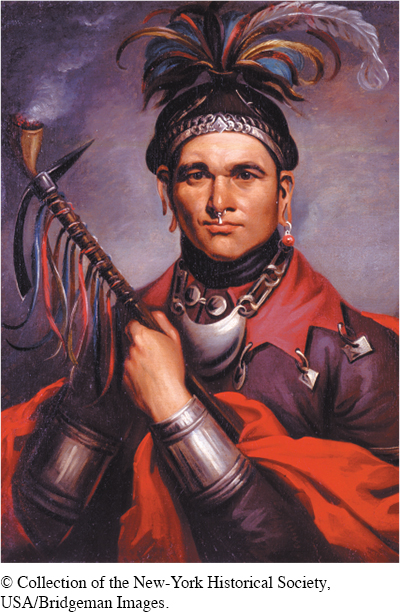The Treaty of Fort Stanwix

Since the Indians had not participated in the Treaty of Paris of 1783, the confederation government hoped to formalize treaties ending ongoing hostilities between Indians and settlers and securing land cessions. The most pressing problem was the land inhabited by the Iroquois Confederacy, a league of six tribes, now claimed by the states of New York and Massachusetts based on their colonial charters (see Map 8.1). [[LP Spot Map: SM08.02 Treaty of Fort Stanwix, 1784/
At issue was the revenue stream that land sales would generate: Which government would get it? The congress summoned the Iroquois to a meeting in October 1784 at Fort Stanwix, on the upper Mohawk River. The Articles of Confederation gave the congress (as opposed to individual states) the right to manage diplomacy, war, and “all affairs with the Indians, not members of any of the States.” But New York’s governor seized on that ambiguous language, claiming that the Iroquois were in fact “members” of his state, and called his own meeting at Fort Stanwix in September. Suspecting that New York might be superseded by the congress, the most important chiefs declined to come and instead sent deputies without authority to negotiate. The Mohawk leader Joseph Brant shrewdly identified the problem of divided authority that afflicted the confederation government: “Here lies some Difficulty in our Minds, that there should be two separate bodies to manage these Affairs.” No deal was struck with New York.
Three weeks later, U.S. commissioners opened proceedings at Fort Stanwix with the Seneca chief Cornplanter and Captain Aaron Hill, a Mohawk leader, accompanied by six hundred Iroquois. (James Madison, by chance traveling up the Mohawk River on a trip with a friend, witnessed the opening ceremonies.)
The Americans (accompanied by their own security detail of New Jersey militiamen) demanded a return of prisoners of war; recognition of the confederation’s (and not states’) authority to negotiate; and an all-important cession of a strip of land from Fort Niagara due south, which established U.S.-held territory adjacent to the border with Canada. This crucial change enclosed the Iroquois land within the United States and made it impossible for the Indians to claim to be between the United States and Canada. When the tribal leaders balked, one of the commissioners sternly replied, “You are mistaken in supposing that, having been excluded from the treaty between the United States and the King of England, you are become a free and independent nation and may make what terms you please. It is not so. You are a subdued people.”
In the end, the treaty was signed, gifts were given, and six high-level Indian hostages were kept at the fort awaiting the release of the American prisoners taken during the Revolutionary War, mostly women and children. In addition, a significant side deal sealed the release of much of the Seneca tribe’s claim to the Ohio Valley to the United States. This move was a major surprise to the Delaware, Mingo, and Shawnee Indians who lived there. In the months to come, tribes not at the meeting tried to disavow the Treaty of Fort Stanwix as a document signed under coercion by virtual hostages. But the confederation government ignored those complaints and made plans to survey and develop the disputed lands. [[INSERT P08.06 Cornplanter. P/

> ANALYZE EVIDENCE
What do the actions of New York’s governor with regard to the events at Fort Stanwix suggest about the effectiveness of the confederation government?
New York’s governor astutely figured that the congress’s power to implement the treaty terms was limited. The confederation’s financial coffers were nearly empty, and its leadership was stretched. So New York quietly began surveying and then selling the very land it had failed to secure by treaty with the Iroquois. As that fact became generally known, it pointed up the weakness of the confederation government. One Connecticut leader wondered, “What is to defend us from the ambition and rapacity of New York, when she has spread over that vast territory, which she claims and holds?”
Understanding the American Promise 3ePrinted Page 208
Section Chronology